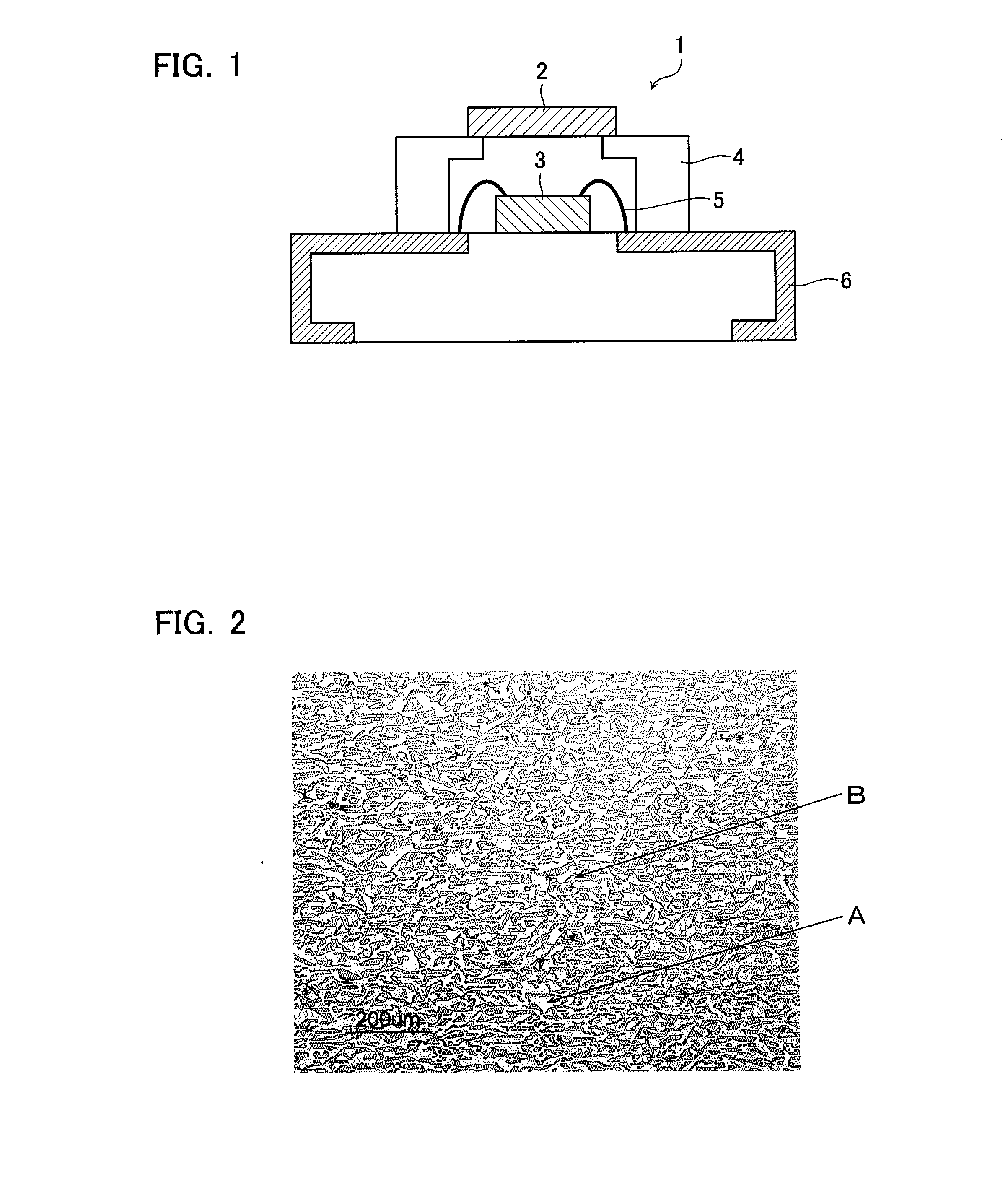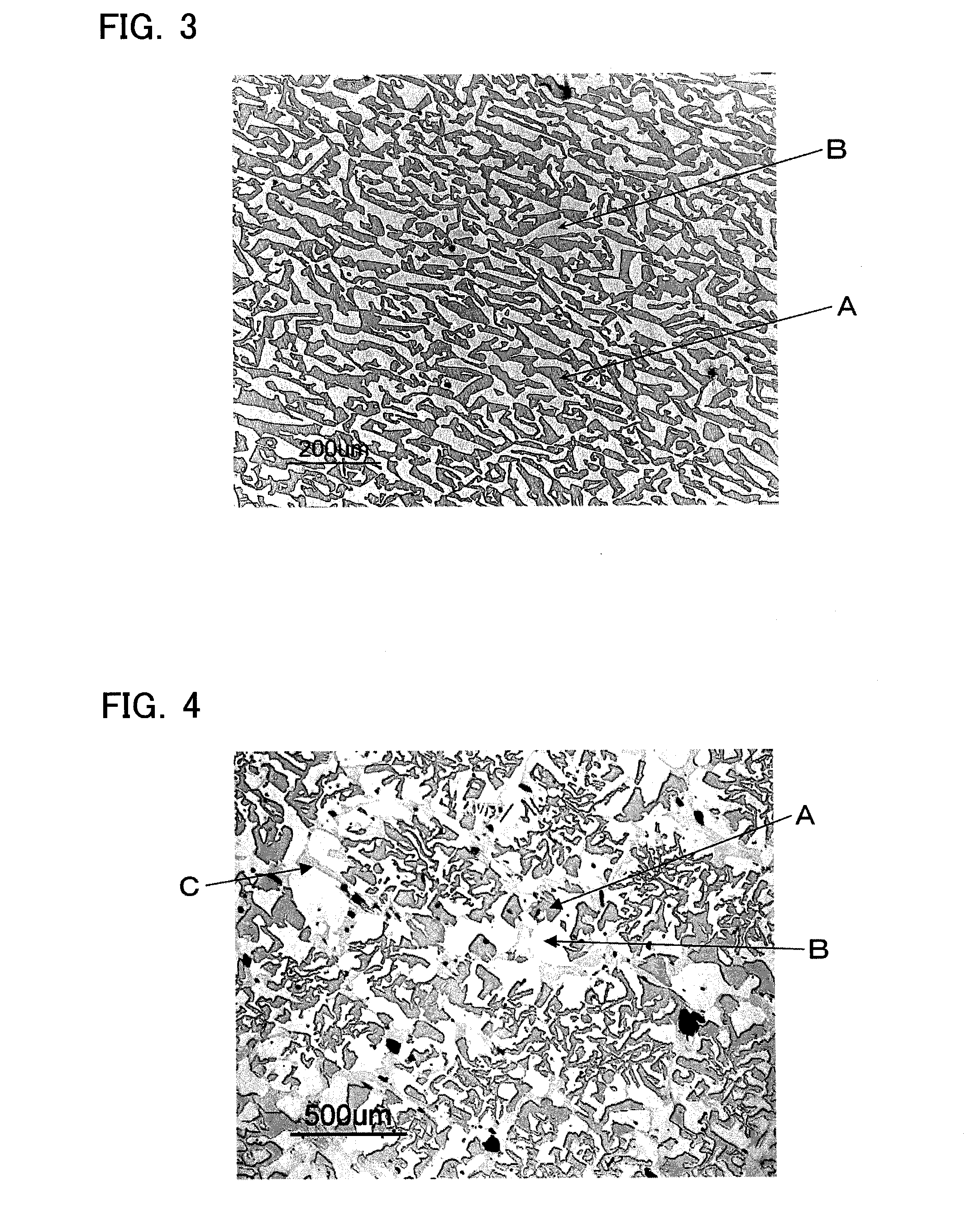Ceramic composite for light conversion, process for production thereof, and light-emitting devices provided with same
- Summary
- Abstract
- Description
- Claims
- Application Information
AI Technical Summary
Benefits of technology
Problems solved by technology
Method used
Image
Examples
example 1
[0064]An α-Al2O3 powder (purity: 99.99%), a Y2O3 powder (purity: 99.9%), and a CeO2 powder (purity: 99.9%) were weighed respectively so as to provide (x′=) 0.7975 mol in terms of AlO3 / 2, (y′=) 0.2025×(a′=) 0.996 mol in terms of YO3 / 2, and (y′=) 0.2025×(c′=) 0.004 mol. These powders were subjected to wet mixing in ethanol for 16 hours by means of a ball mill, and then to the removal of ethanol as a solvent with the use of an evaporator to obtain a raw material powder. The raw material powder was preliminarily dissolved in a vacuum furnace to provide a raw material for unidirectional solidification.
[0065]Next, this raw material was directly put in a molybdenum crucible, the molybdenum crucible was set in a dissolution holding zone of an unidirectional solidification apparatus provided with the dissolution holding zone in an upper section and a cooling zone with a temperature gradient of 100° C. / cm set in the vertical direction (solidification direction) in a lower section, and the raw...
example 2
[0076]Except that α-Al2O3 powder (purity: 99.99%), a Y2O3 powder (purity: 99.9%), and a CeO2 powder (purity: 99.9%) were used as raw materials respectively for 0.7857 mol in terms of AlO3 / 2, 0.2143×0.993 mol in terms of YO3 / 2, and 0.2143×0.007 mol, and that the lowering speed of the molybdenum crucible was adjusted to 5 mm / hour, a solidification product according to Example 2 was obtained by the same process as in Example 1. FIG. 3 shows a micrograph of a sectional texture perpendicular to the solidification direction in the portion of the solidification product other than a skin thereof. A black section A corresponds to the second phase (Al2O3 phase), whereas a white section B corresponds to the first phase (YAG:Ce phase).
[0077]As in the case of Example 1, the x, y, a, and c in the formula (1), the total area (% by area) of the first phase and second phase to the entire cross section of the solidification product, the fluorescence peak wavelength (nm), Cy, and the total radiant flu...
example 3
[0078]Except that α-Al2O3 powder (purity: 99.99%), a Y2O3 powder (purity: 99.9%), and a CeO2 powder (purity: 99.9%) were used as raw materials respectively for 0.7857 mol in terms of AlO3 / 2, 0.2143×0.989 mol in terms of YO3 / 2, and 0.2143×0.011 mol, and that the lowering speed of the molybdenum crucible was adjusted to 4 mm / hour, a solidification product according to Example 3 was obtained by the same process as in Example 1.
[0079]As in the case of Example 1, the x, y, a, and c in the formula (1), the total area (% by area) of the first phase and second phase to the entire cross section of the solidification product, the fluorescence peak wavelength (nm), Cy, and the total radiant flux were found out for the portion of the obtained solidification product other than the skin thereof. The results are shown in Table 1.
PUM
| Property | Measurement | Unit |
|---|---|---|
| Fraction | aaaaa | aaaaa |
| Speed | aaaaa | aaaaa |
| Wavelength | aaaaa | aaaaa |
Abstract
Description
Claims
Application Information
 Login to View More
Login to View More - R&D
- Intellectual Property
- Life Sciences
- Materials
- Tech Scout
- Unparalleled Data Quality
- Higher Quality Content
- 60% Fewer Hallucinations
Browse by: Latest US Patents, China's latest patents, Technical Efficacy Thesaurus, Application Domain, Technology Topic, Popular Technical Reports.
© 2025 PatSnap. All rights reserved.Legal|Privacy policy|Modern Slavery Act Transparency Statement|Sitemap|About US| Contact US: help@patsnap.com



